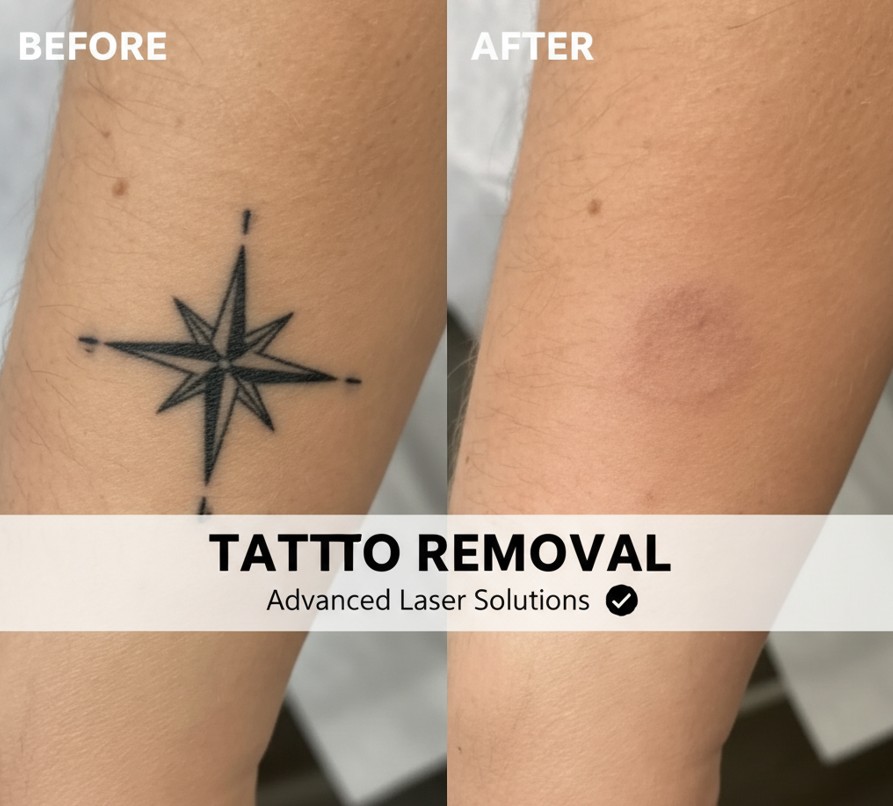Tattoo removal lasers are powerful medical devices designed to break apart ink that was meant to be permanent. When performed by an experienced practitioner, treatment is generally safe and effective. However, many patients worry: “Will tattoo removal leave a scar?” The answer depends on several factors, including your skin type, the technology used, and how well you follow aftercare instructions.


If you are considering treatment, it’s important to understand the risks. Choosing a skilled and credentialed provider is the best way to lower the chance of scarring. Proper technique and patient aftercare can make all the difference in whether you heal smoothly or develop unwanted changes in the skin.
Do Removed Tattoos Leave Scars?
Most patients do not develop permanent scars from laser tattoo removal. That said, improper treatment can result in complications. Scarring may appear in different ways:
- Hypopigmentation (skin lightening)
- Hyperpigmentation (skin darkening)
- Textural changes (raised or uneven skin)
These side effects can be temporary, but sometimes they last longer, especially if treatments are done too aggressively or without proper healing time between sessions.
Before and After Laser Tattoo Removal Scars
Patients often look for before and after laser tattoo removal scar photos to understand what healing looks like. In most cases, skin gradually returns to a normal appearance as the body clears the broken-down ink. But when scars do form, they may appear as shiny patches, thickened skin, or small areas of discoloration where the tattoo once was.

So, what does a tattoo scar look like? It can range from faint changes in pigmentation to more obvious texture differences. Choosing a reputable clinic greatly reduces the chances of these outcomes.
What Causes Scarring After Tattoo Removal?
Scars from laser tattoo removal are most often caused by:
- Using laser energy settings that are too aggressive
- Not allowing enough healing time between treatments
- Poor aftercare, such as sun exposure or scratching the treated skin
In some cases, scarring may already exist in the skin from when the tattoo was originally applied. This can become more noticeable once the ink fades.
Can Tattoos Cover Scars?
If you already have scars from tattoo removal or from the tattoo itself, you may wonder: Can a tattoo cover scars? The answer is yes, but timing is important. How old do scars have to be to get a tattoo? Generally, scars should be fully healed—often 12 to 18 months—before new ink is applied. Fresh scars are more sensitive and may not hold pigment evenly.
How to Minimize the Risk of Scarring
- Choose a licensed, highly trained practitioner with experience in laser tattoo removal.
- Make sure the device used is appropriate for your skin type.
- Follow post-treatment care carefully: keep the area clean, moisturized, and protected from the sun.
- Allow full healing between sessions. Rushing treatments increases the risk of damage.
Common FAQs
1. Do removed tattoos leave scars?
Most tattoos removed with proper laser treatment do not leave permanent scars. Temporary changes like redness, lightening (hypopigmentation), or darkening (hyperpigmentation) are common but usually heal over time. Scarring is rare when a licensed practitioner performs the procedure correctly.
2. What does a tattoo scar look like?
A scar from laser tattoo removal can appear as raised or indented skin, shiny patches, or slight discoloration. In most cases, the changes are subtle, but aggressive treatments or poor aftercare can make scars more noticeable.
3. Can tattoos cover scars?
Yes, healed scars can often be covered with a new tattoo. The texture and color of the scar may affect how ink settles, so it’s best to wait until the scar is fully healed—usually 12 to 18 months—before considering a cover-up.
4. When you get a tattoo removal, does it scar?
While minor side effects like redness or temporary pigment changes are common, permanent scarring is rare. Scarring risk increases if treatments are too aggressive, sessions are too close together, or proper aftercare is not followed.
5. How old do scars have to be to get a tattoo?
Scar tissue should generally be fully healed and stable before getting a new tattoo, which can take 12–18 months. Fresh scars may not hold ink evenly and could become irritated if tattooed too soon.
So take step
When done correctly, tattoo removal rarely results in permanent scarring. But it’s natural to wonder: “When you get a tattoo removed, does it scar?” The best protection is doing your homework and selecting a trusted provider.
If you already have a scar from laser tattoo removal, cosmetic treatments and scar revision options may help improve its appearance. Always consult with a qualified medical professional to discuss your concerns.

